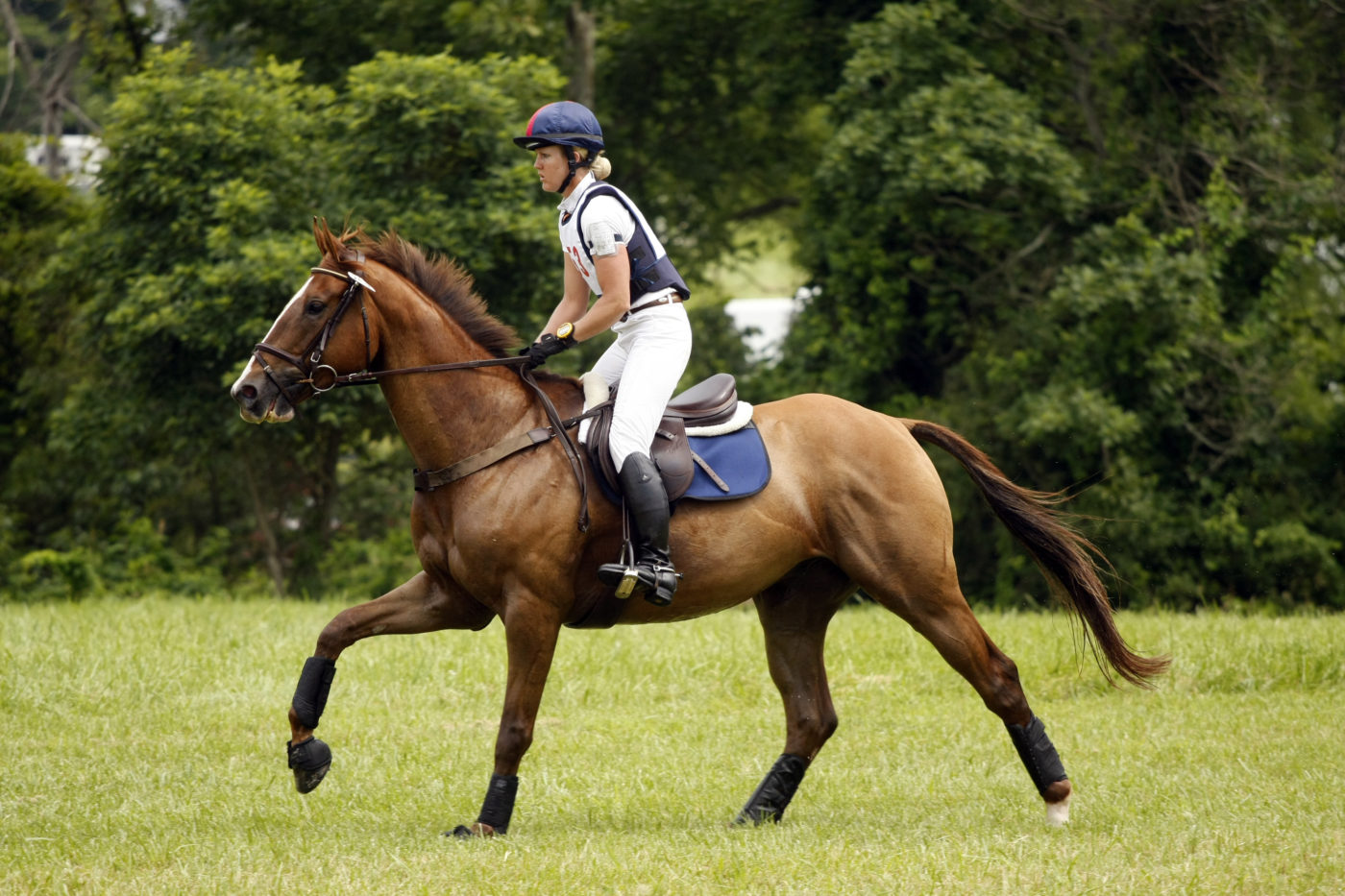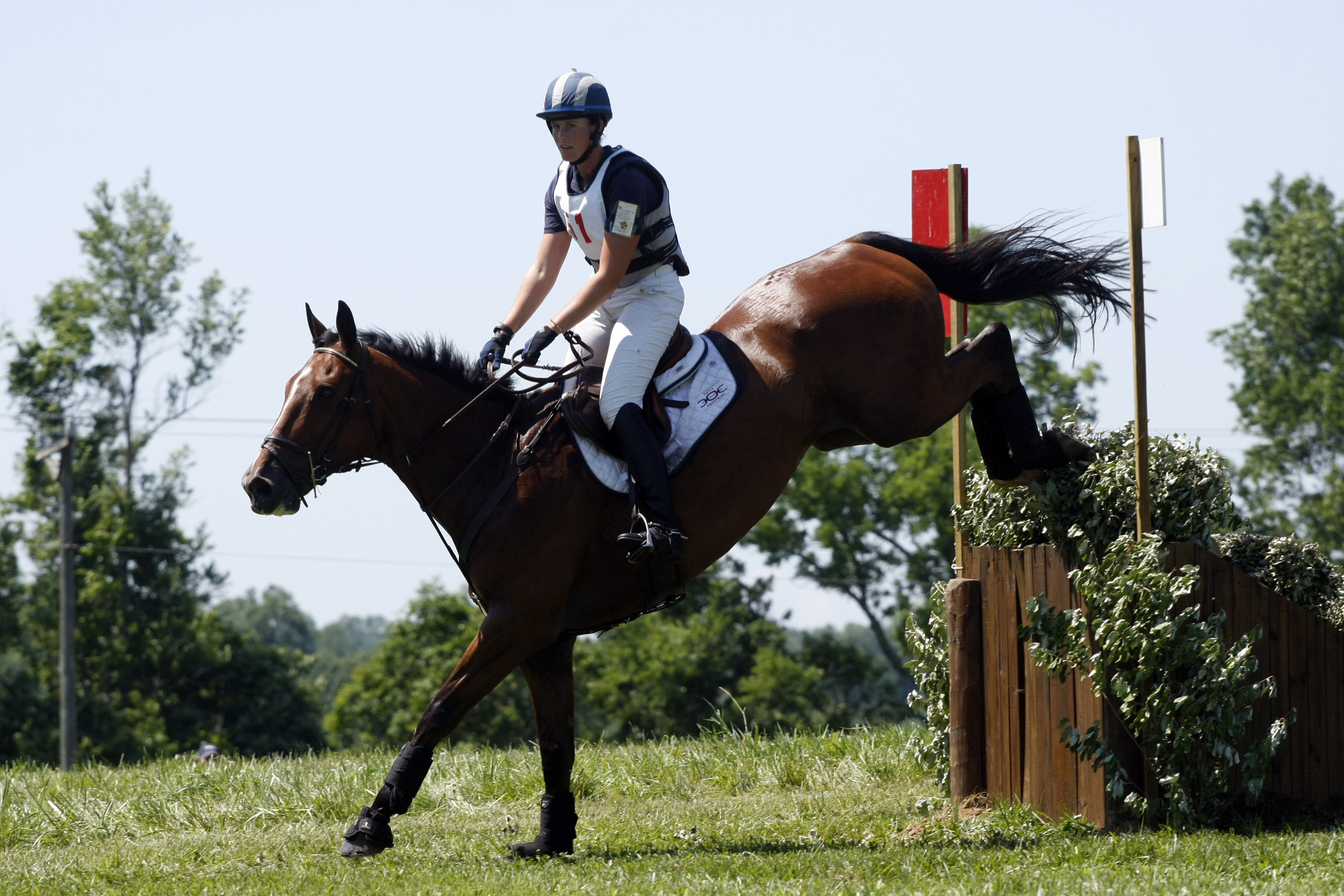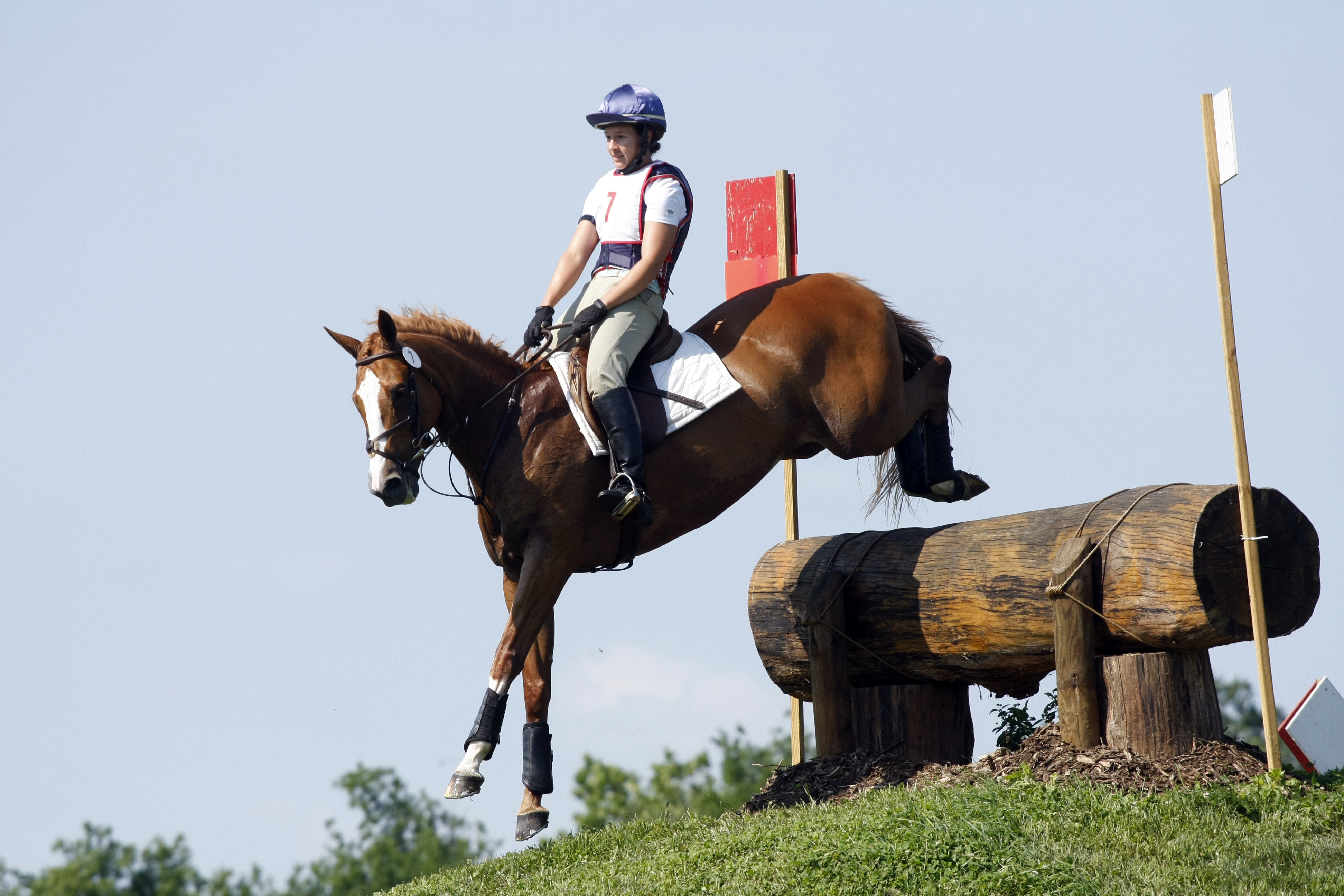

This article was originally published in volume 38, issue 4 of Eventing USA magazine and is the third in a four-part series geared toward making cross-country riding safer written by renowned horseman, William Micklem. Click to read part one and part two.
Modern cross-country courses have an emphasis on related combinations, often including one or two ‘skinny’ fences. It is therefore vital to understand how the stride length is affected by different factors so that you can make the distances work for you and reduce the room for error and risk. It is also vital to develop a ‘second nature’ safety position.
What are the factors that influence the length of a horse’s stride? The most obvious one is that the stride will naturally tend to lengthen when a horse goes faster and shorten as they go slower. A normal show jumping stride length is just over 3.5 meters at a speed of approximately 400 meters per minute. A good rule of thumb is that the stride length will shorten or lengthen by a meter for every 100 meters per minute slower or faster than this that you go. So a speed of 300 meters per minute, suitable for a typical drop fence, will give a stride length of approximately 2.5 meters, and a speed of 500 meters per minute, suitable as a basic speed for those starting cross-country, will give a 4.5-meter stride.
There are a number of other major factors that will change the length of stride, such as going up and down hill and the state of the going, and more minor factors, such as how supple the horse is or whether or not they are jumping towards or away from their stable. Some distances between fences appear short because the horse is jumping extravagantly, while if your horse is just creeping over the fences the reverse will be true. These variable factors emphasize the need to both know your horse well and to use a coach to find the right speed and stride lengths for each combination. Of course, your insurance policy in all these situations is to have a horse with a good fifth leg that will be able to do much of the work for you.

In addition to the need for fifth leg training, I use my three cross-country ONs to emphasize the priorities that need to be established before riding in competition - kick ON, stick ON, and get ON the next day. By keeping things simple like this it gives a focus to your cross-country training and planning that will without doubt reduce the risks you take.
You can get ‘in gear’ at home by warming up well, with particular emphasis on your horse going forward from the leg with a normal rein contact. Do this until you can lengthen and shorten the canter with ease with your horse staying ‘between the aids’ and going with genuine impulsion. Having both you and your horse ‘in gear’, both mentally and physically, is obviously a key requirement for cross-country riding, and your ability and confidence to use your legs and kick on is a major part of the recipe for achieving this.
A rider must be prepared to be assertive and kick at times and occasionally back up the leg with a stronger aid or the use of spurs. This is not to be done as a substitute for good preparation or because the task is simply too difficult. If the preparation has been thorough and the fence size is appropriate, then it is safer to use a stronger leg aid if the horse temporarily forgets the urgency of staying ‘in gear’, rather than end up jumping a fence half-heartedly, frightening your horse, and possibly dislodging you because of an awkward jump. If you are ready to ride cross-country you are also ready to wear spurs, which should have big round soft ends or the plastic ends which rotate are popular in dressage. Unless your horse is over sensitive to the leg it is probably always better to have them available for use if required.
Equally, if you can only stay in gear by continually using strong leg aids or the spurs, there is something very wrong with the preparation. You must reassess the situation to decide whether your horse needs more flatwork, smaller fences, or a check for pain and discomfort. Many horses become unwilling because they have, for example, foot pain or a pinching saddle. Or often it is the rider’s position and method that needs attention.
Some people talk about the ability to stick on as though it is something magical that is given only to a special few. But ‘stickability’ can be taught. A balanced position, combined with real softness and suppleness, which allows you to move with the movement of the horse, and in particular a secure position of the lower leg, will all make falling off difficult.
Softness and suppleness are greatly underrated because if you become at all rigid you can get bounced off like a ball off a bat. But the area we really need to pay more attention to is the rider’s position during the second half of a jump. To highlight this I call it the safety position, but in fact the ingredients for a safety position are the same for all fences, and cross-country riders need to work hard to have a safe position over every fence. In fact, I would like to see all riders show their proficiency in using a safety position before being allowed to compete.
For the horse trials rider, it is necessary to open the angles of the knee and hip in the second half of the jump (see diagram 1) so that a secure balance can be maintained down drops and in case the horse hits a fence. In the safety position the lower leg stays perpendicular, which means as the horse descends that the heel has to move forward in front of the girth and you have to ride short enough to keep the seat clear of the saddle. If you ride too long it is not possible to both keep the lower leg secure and the seat clear of the saddle, with the result either that the lower leg swings backward or that the rider's seat gets a kick forward from the saddle. In either case, it is an accident waiting to happen and the end result is often a soaking in the water jump! We need to work at the safety position:

There is a simple progression to establishing a ‘second nature’ safety position that is seldom used.
As well as being more secure it will also mean that you will be in a better position to steer your horse on landing towards the next fence. This will make a huge difference in water fences, as it is the loss of the rider’s balance as they drop down into the water that is a major factor in making water fences so influential.
Unfortunately, riders are often not well served by their coaches in the area of drop fences. “Sit back” these coaches cry, with the result that their students end up leaning back with their seat in the saddle, and their lower legs moving back trying to balance themselves (see diagram 2). Then the direct contact with the saddle combined with no leg support means they are kicked forward by the horse’s back, or the force of landing, and end up on the horse's neck or on the ground, or worst of all in the water. What you should do is not think ‘back’ but instead ‘up’, as the angles are opened, allowing the reins to be slipped a little and remaining supple. In this position it is also possible, in emergencies, to put the foot a little more forward for extra security.

Finally, never forget that good cross-country preparation will allow you to get on again the next day, rather than horse and possibly rider having to stay at home nursing stiffness, wounds, or a loss of confidence. ‘A horse is not a machine’, we all keep saying, so make the training truly progressive and enjoyable and make a good fitness program a non-negotiable part of your overall plan. Horses should not be just fit enough, they should be more than fit enough to avoid tiredness and injuries. A good fitness program is an integral part of your safety strategy and will mean that your horse is prepared to cope with slightly greater demands than he will face in the competition. This should largely eliminate tiredness and thereby substantially reduce the risks, as well as keeping your horse happy in their work.
If your horse is tired because of a lack of fitness then you risk injury to the horse and, much worse, injury to yourself. In this situation, you must pull up. Particularly if you are near the end of the course it is very tempting to continue, but it only takes one fence to have a fall so do not be tempted. In the excitement of competition some riders also lose their feel and go too fast, which will quickly tire the horse. This is why it is so important to establish methods of judging the speed in training and competition. Occasionally, despite good preparation and good riding, your horse will tire because of being unwell. Always be sensitive to abnormal behavior and check their temperature, pulse, and respiration as a matter of habit. It is important to have a meticulous program of health checks, to both establish what is normal for your horse and be able to treat a small problem before it becomes a big problem.
Equally, you must be fit enough as a rider. Fit enough to go 15 minutes with the seat out of the saddle before you enter a cross-country of five minutes. If you are also fit enough to easily vault on and off your horse, then riding becomes a safer activity. Then you will also be able to get on again the next day and enjoy one of the most exciting and wonderful sports in the world.

Sonya Duke epitomized a rider who was able to kick on, stick on, and get on the next day from an early age. The first photograph shows her at Badminton on her great 15.3 hand Carbrooke Charles (Chas). At the age of only 19, she rode her first Badminton like a veteran with a wonderful positive attitude and positional security. In addition, as a result of her superb planning and stable management, she was able to bring the 18-year-old Chas out the next day to jump a fabulous athletic clear round in the show jumping. The other two pictures say everything about her stickability. They were taken at the European Championships at Punchestown when she won a team silver medal. Here in this difficult combination, it is obvious to see that Sonya never gave up and never lost her ‘second nature’ safety position.
Growing up in a family of horsemen in Cornwall, England, William Micklem and his five siblings spent their childhood competing in Pony Club activities and hunting with the Fourburrow Hunt. After passing his British Horse Society Instructors Certificate (BHSI) in 1973, William went to work as chief instructor for Robert Hall in both Fulmer, England, and Pepperell, U.S., which is when he began a lifetime equestrian association with Karen O’Connor, before coming to Ireland to work for Bord na gCapall (The Irish Horse Board) in 1976. He also started training the Irish Junior and Young Rider Horse Trials Teams and designed Ireland’s renowned Golden Saddle Scheme for top young competition riders from dressage, show jumping, and horse trials. He passed his Fellowship of the British Horse Society in 1981. Micklem has found horses for some of the top riders in the world, including Biko, Custom Made, Giltedge, Mr. Maxwell, and Mandiba for the O’Connor Event Team. To find out more about William Micklem, visit his website at www.williammicklem.com.
Are you following along with the action from home this weekend? Or maybe you're competing at an event and need information fast. Either way, we’ve got you covered! Check out the USEA’s Weekend Quick Links for links to information including the prize list, ride times, live scores, and more for all the events running this weekend.
Last month, readers met VIP Volunteer Rebecca Proetto, who volunteered at the MARS Maryland 5 Star horse inspection. This month, the focus turns to husband and wife Ed and Leanne Barnett who introduced Proetto to the art of running an efficient horse inspection at Maryland. Ed and Leanne undertake a 12-hour drive from their home in Indiana to Maryland just to volunteer at the event.
The USEA is saddened to share the passing of Sara Kozumplik’s five-star partner As You Like It at the age of 34. The gelding died in his sleep at his retirement home at Kozumplik's parents' residence.
The 2024 USEA Emerging Athletes U21 (EA21) National Camp is just a little over a month away and all over the country, young riders are preparing for their trip to Ocala, Florida, to participate in this year's prestigious week-long academy led by U.S. eventing legend David O'Connor. This year's camp takes place Dec. 31, 2024, through Jan. 4, 2025, and will feature classroom sessions, guest lecturers, and in the saddle work as a group to help strengthen the foundation of each rider selected to participate.